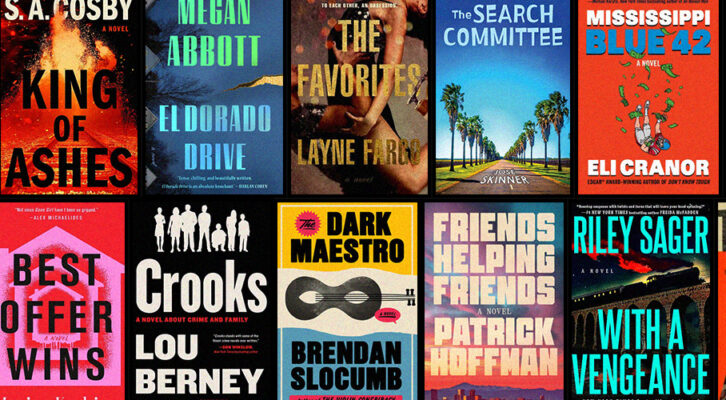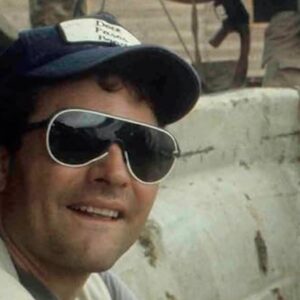
Interview with a Gatekeeper: New Directions' Declan Spring
On the Wonderful Past, and Bright Future of James Laughlin's Legendary Press
Declan Spring shows me around New Directions Publishing Company where he is an editor. On the walls, a prescription for nasal spray made out to James Laughlin by William Carlos Williams, paintings by Henry Miller and Kenneth Patchen, and a photo of Thomas Merton with the Dalai Lama. In Declan’s compact office, Ezra Pound’s file hangs dog-eared and mashed into a file cabinet. A cherry tree, tended to by Executive Vice President, Laurie Callahan, grows in a pot on the small balcony outside; once a year she makes a pie for the staff with its fruit. The bedraggled carpet, the narrow hallway, the outdated filing system—all testament to the frugality of New Directions and to their focus on publishing great literature rather than decking out their offices. Declan is happy to talk about New Directions’ storied past, but he’s also confident about its future.
//
Kerri Arsenault: How did you get into editing?
Declan Spring: I was going to graduate school at NYU for my MA in English. I had wanted to teach high school English but by the time I got my MA I was fried on school and having trouble getting a teaching job at a private school. While I was at NYU I was answering phones at New Directions at the front desk. Eventually an editorial position opened, so I just started working on some editing projects.
KA: Did you work directly with James Laughlin?
DS: When I started James Laughlin was still around and living up in Northern Connecticut, so he wasn’t in New York much, but he kept very close tabs on us. I also started helping with permissions and contracts. Now I’m in charge of all our contracts. I was also working with reprints, which didn’t really involve editing. It was just seeing the project through. New Directions is small enough so that you work in lots of different jobs.
KA: What were the first books you helped edit?
DS: One was Anne Carson’s Glass Irony, and God, which was also one of the first books we published of hers. I also worked with Guy Davenport. He and Laughlin were good friends and correspondents and shared a lot of the same interests. So I was assigned those books. I didn’t totally know what I was doing.
KA: Wait, so your answering telephones at the front desk and the next thing you know you are the editor of Anne Carson’s Glass, Irony and God?
DS: Yeah. It was a couple years before I was actually doing that. It was kind of funny because when I first began working there, I still really wanted to teach. I was working at New Directions, sort of unsure about things, and I remember I started working on the Davenport and Carson books and I began to understand the history of New Directions and I was working with some really important writers. It was then I realized, this is actually a once in a lifetime opportunity. Then not long after, I remember driving home one night after a party, and it dawned on me; I was really loving what I was doing. I thought, maybe this is what I should be doing. I was so lucky because the people running New Directions at the time were part of the old guard of publishing. They were very generous with me and showed me how to do the work. They also understood the nuts and bolts of running a small business and were very careful.
KA: What are the differences between the old guard and the new guard?
DS: There are still some of the old guard working in publishing now that I respect so much. What I loved about New Directions when I first started was how un-corporate everyone was. Everyone loved literature and was incredibly intellectual. To work at New Directions, you couldn’t have high notions about being a fancy editor with an assistant and an account at an expensive restaurant. Everyone chipped in where needed, not just doing the glamorous stuff, but carrying boxes of books into the production office, refilling the water cooler when the water jugs run out. We’ve had people start working for us with very high-minded notions about being an editor and working with the authors, but they didn’t get it, and they didn’t last long.
KA: Working as an editor is more than just reading manuscripts.
DS: Exactly. When you run a small company like that you really have to have your fingers in lots of different places. Peter Glassgold, who was the Editor-in-Chief at the time, taught me about not moving to the next stage of production until you are sure everything’s been done properly. Peggy Fox was the publisher for quite a few years while I was working and while I was working closely with her handling… well, New Directions has been the agent for the Ezra Pound and the Hilda Doolittle estate and was the agent for the William Carlos Williams estate. Peggy taught me never to cut corners.
KA: You are/were agent and publisher for those authors?
DS: Yeah, that was something that sort of worked out. James Laughlin was close with the families and they needed someone to help with the translation rights and also their huge library archives, which scholars wanted access to and permission to use.
KA: Do you still handle those estates?
DS: Yes, for Ezra Pound, but we aren’t doing that that for William Carlos Williams anymore. I email frequently with Pound’s daughter, Mary de Rachewitz, which is thrilling for me. She is so kind and so learned. The Hilda Doolittle heirs pay attention but they aren’t quite as involved. So under all these people I learned so much. But editing was always sort of a mystery to me.
As in most places, they don’t give you complicated editing projects until you’ve proven yourself. I remember not knowing how to do it or what was involved, so I took an editing class with Beena Kamlani at NYU in their publishing program while I was working at New Directions. One of the first things she taught me was how to write a letter to the author with changes and always say something like, these changes are just suggestions. Feel free to stick with what you want, feel free to disagree where you see fit or if you want to rework things. That is still my basic approach and principle in working with an author or translator. Carol Houck Smith at Norton told me once that you can’t really learn anything about editing, you’ve got to just do it.
When I was new to editing, Barbara Epler, another amazing editor who is now our Publisher, was working on some stories by Victor Pelevin, this crazy Russian writer. She gave me a manuscript of a translation of couple of his stories and said, work on these and then look at my edits. That’s how I got the feel of it.
KA: Is your influence ever in a text?
DS: I am very careful and nervous about about making suggestions to authors or intruding too much. I certainly don’t feel comfortable making changes after reading something just once. I feel I need to read it multiple times. Having that experience of reading, then reading it again, where you feel like you hear the voice, you have the structure of it, you know where it’s going. That second reading—I mean, that’s one of the joys of editing. Most people who read books read them once. They don’t go back and have that experience of reading something multiple times. When you’re editing, you’re reading it a third or fourth time and you see how a book works on all these different levels that you may have missed if you read it just once. Things just pop out at you.
Some of the early books I worked on were by Peter Handke, one of my favorite writers, and then I worked on some books by Paul West, but that was a completely different experience than working on translations.
KA: How’s that?
DS: A couple of novels Paul submitted really needed revisions. He wrote these experimental historical novels, but they were fiction. I remember Paul was writing this novel Cheops about the Egyptian pharaoh who’s about to die and the music of the English composer Frederick Delius is piped into his ears. This parallel narrative with Cheops and Delius just went on. It was over a 500-page manuscript! I said he needed more stepping stones. So I wrote him a long letter. That’s totally different than translations, which are mainly just line editing.
KA: Tell me about working on translated texts. Are you fluent in any foreign languages?
DS: I speak a teeny bit of French but I’m not comfortable in any language where I can refer to the original and make my own edits.
KA: Is that weird?
DS: People ask me that a lot; how can you feel comfortable or secure editing a translation when you don’t speak the language. I’ve heard some editors say it’s actually difficult knowing the original because you’re always comparing it with the translation, which can hang you up on some things. We’re so lucky because we work with all the best translators. So if I come across something that doesn’t sound right to me, I ask them. Sometimes they’ll refer to the author if it’s something they don’t have the answer to.
KA: What is your percentage of translated works?
DS: Most of the fiction we publish is in translation, although we have been publishing American novels by writers like John Keene, Helen DeWitt, and Forrest Gander. We also brought out this really interesting writer from the 1970s, Fran Ross, an African-American who wrote this overlooked classic, Oreo. So yes, we also publish English speaking writers. We publish most of Muriel Spark. And we publish a lot of American poetry.
KA: I was just speaking with Elisabeth Schmitz at Grove and we had a long discussion on literary scouts. How do you find all these incredible foreign writers? Do you use scouts?
DS: A lot of it is being in touch with publishers from other countries that are similar to us. We are always getting suggestions from foreign publishers, like Hanser and Surhkamp in Germany, Adelphi in Italy, Christian Bourgois in France. And the European publishers do literature from other countries, too, that people are not aware of. Our translators also recommend things.
KA: So it just comes to you?
DS: Yeah, mostly. We get all the catalogs from the European publishers and look through those, too. People are always recommending things to us.
KA: It’s interesting that there’s this whole conversation about diversity in publishing and I find that the conversation seems to be narrow in its definition of diversity. All these foreign authors writing in other languages, I would consider that quite diverse. There’s different ways to look at diversity other than skin color.
DS: I think most publishers would say, we’re not going to publish an author just because he or she is Latino or Black or something.
KA: Actually, nobody has said that to me yet.
DS: Our mission is to publish the highest quality literature no matter who the author is.
KA: What are your thoughts about diversity in publishing?
DS: I’m not paying really close attention to it, but you can’t help but notice when you’re at book parties or when you have lunch with an editor, inevitably it’s someone from a good college and is white.
KA: We talked a little about your being mentored by these people from the “old guard” of publishing and I am wondering if you could expand a little on that. New Directions has such a deep history and you are a touchstone to that history because you worked alongside James Laughlin. It’s kind of rare. How has New Directions changed over the years?
DS: The mission has always been to adhere to James Laughlin’s philosophy of publishing writing that’s different and new and avant-garde. He always had this view of publishing that you sign on books that are going to be lasting. So you’re not looking for the next bestseller. Any book worth it’s salt is going to be read and appreciated 20 years after it’s first published. We take a long term view of publishing.
KA: Interesting because “long term view” and “avant-garde” seem to be at odds…
DS: Not really, though, because we’re looking for writers who are undiscovered, unappreciated, unrecognized. When we first started publishing Pound, Williams, Dylan Thomas, Marianne Moore, nobody knew who they were. They were too weird and hard to understand. Now they’re part of the literary canon.
KA: New Directions is one step ahead…
DS: Yeah, it pays off because the backlist is our bread and butter. Seventy-five percent of our sales are from our backlist. I was talking to Jonathan Galassi about that recently and he’s like, If I had that I’d be so happy. James Laughlin always felt to stay small was important, to operate on a not expensive scale. Our advances are not very large. We keep our staff small. We keep our expenses down as much as possible. Basically, what we are trying to do is keep the company going. The goals are to pay salaries, pay the rent, pay the production costs, pay the authors, and have money in the bank so we can continue publishing books. If you look at the profits every year, they’re little, but enough to keep things going. New Directions has been successful doing that for a very long period of time. Barbara Epler figured out that every year we have one or two pretty good selling front list books. For a big commercial publisher, it wouldn’t seem like much. But for us, if a hardcover book sells 10,000-15,000 copies, that ends up being a good year for us.
Recently, we are starting to be a little bit more profitable. We have this great staff and it’s a really exciting time to be at New Directions. All along we’ve had one publicity person trying to publicize and market all those books. So for the first time we have two publicity directors and we’ve seen incredible results. So many more of our books are reviewed in the Times and in the major book reviews. We are getting more reviews, more orders, and more sales. It’s really paying off, but at the same time we are always trying not to overextend our financial parameters.
KA: That may be a problem with publishers that depend on blockbusters… that it distorts everything else in sales, production, author advances, etc.
DS: Right. You give a big advance for a book and if it doesn’t sell hundreds of thousands of copies, you lose.
KA: I was speaking with Carlos Lozada, book critic for The Washington Post, about Barack Obama’s next advance—people are estimating it will get $16-$18 million-dollar advance. Then there’re all the other authors who are barely scraping by. If a publisher counts on blockbusters to pay everyone else—authors, staff, etc., that seems riskier than publishing the kind of literature you are…
DS: James Laughlin was notoriously careful and New Directions is known for being frugal. There’s almost a feeling like history takes its course. One way New Directions has changed is that we’re being a lot more proactive about reaching out and developing our own relationships with stores. I’ve been working at New Directions for 20 years and the sales reps who go out to bookstores and sell our books, a lot of them have been there as long, if not longer, than I have. They’ll give us feedback and make suggestions about how we can sell our books better, package them better, market them better, etcetera. But our editors and publicity people are now traveling around and making visits, asking the booksellers what we can do to help them sell our books.
KA: Speaking of, what did you think of that article, “Moneyball for Book Publishers: a Detailed Look at How We Read” from the New York Times about data on e-readers. It suggests readers are the ultimate gatekeepers.
DS: That was crazy, right? Another reason I think we are in a fortunate position—I mean, we’re always interested in finding out more information about who are readers are, and any information you can get like that is helpful—but we’re really lucky because we have this long history. Libraries all over the country order New Directions books because they know what we do. Many independent bookstores also automatically order large quantities of our new books because they know our tastes and recognize that it’s good for their store to stock copies of our books. If we start worrying too much about that kind of thing, well…
The other thing that is really great is that there are a lot of young readers who really love New Directions. We have this party every year during BEA. Drenka Willen came to our BEA party and said, Barbara [Epler], this is a sign that New Directions is thriving. Look around and you see all these young people who are excited and they’re talking about your books, that’s what you want. Plus, we are just lucky. We’ve always had great people running New Directions, but the last few years are some of the more financially successful years we’ve had.
KA: Really?
DS: Well there were some really scary years. There was the economic collapse, then, all of sudden, instead of people dropping $50 on Amazon to buy books, everyone was freaking out. Then Borders collapsed. That was really intense because all those books got returned and our sales were low anyway.
KA: How did you survive?
DS: We stayed the course.
KA: Where are these younger readers coming from?
DS: All over. When I travel to other cities, I see people out of college carrying ND tote bags. In New York when our authors give readings, you see so many people in their twenties, early thirties, coming up and asking the author to sign their books.
KA: Tell me about your editorial style.
DS: Every book is different. Every working relationship you have with the translator and author is different and every book has different issues. You’ve just got to figure it out. I don’t approach a book in one way and I like that aspect of editing. You’re always learning. It’s always kind of scary to send changes to an author who you’ve never worked with. There’s always this feeling of… are they going to hate this? I just finished editing a novella by this writer from El Salvador, Horacio Castellanos Moya. The translator, Lee Klein, lives in Philadelphia. After sending the edits, I spent a few days worrying, anxious. I hadn’t heard back from Lee in a few days so I said, Lee could you just tell me if it seems OK to you? He said, so far so good. So now I can calm down.
KA: You go back to the translator not the author?
DS: You almost treat the translator like the author. A lot of our books, the authors are paying very close attention and waiting for their book to come out. Actually, Castellanos Moya wanted to read the English translation just to make sure, and he sent his own suggestions, which were really helpful to the translator and me. Sometimes authors do that and it interferes because their English may not be perfect and they may get an academic to look at it and they’ll take issue with a word or two and the author freaks out. Or when I was working on that Jenny Erpenbeck book, The End of Day: There was a chapter where an immigrant was on Ellis island and he’s in the immigration office waiting to see if he’s going to get into the country. He sees a black immigration officer and I said, they didn’t have black immigration officers at that time. So Susan Bernofsky, the translator, went back and talked to Jenny and she said, well, this is sort of imagination. And I said yeah, but reading it, it feels like a mistake.
Jenny just wrote a novel about the African immigration crisis and Susan’s handing in the translation at the end of this fall. It usually takes us a year after receiving the finished manuscript to publish the book, to give us time to edit it properly, especially with these experimental texts and with a translator. You need at least six months to get galleys. So Jenny was anxious because it was going to take so long. In Europe she gave the manuscript to her German editor and they published the book four months later. We had to explain to her that in the US it’s different.
So the authors do get involved to a degree. Another author I edited, Enrique Vila-Matas… I feel comfortable editing and making suggestions because I know his style—and him—pretty well. And Enrique’s English isn’t so good and he can’t read the translation as much, but he’s very anxious about the book: when it’s going to come out, how it’s going to come out, when we are going to promote it, what the cover is going to look like… He’s involved.
Another author I’m really excited about is this Norwegian writer, Dag Solstad. Knausgaard admires him very much, as do other writers like Peter Handke, Lydia Davis, and Murakami. He writes in these long sentences with a very unsettling humor. I think he’s going to be a big hit. We’ll be bringing out two of his books at the end of next year.
One of your questions was how do you know if it’s a New Directions book? A lot of it is “does this sound like a New Directions book?” It’s sort of a puzzlement, or I’m not getting this…
KA: Like some New Yorker cartoons?
DS: Right. That’s sometimes a good sign, if you are struggling to even enjoy it that’s often the first indicator that it’s a New Directions book! Then you stick with it and start understanding what the writer’s doing and by the end, it’s just wow, this is totally different.
KA: If you are puzzled reading it, what is the average reader thinking?
DS: We get these emails from people who work in stores, not buyers, but the men and women who are stocking the shelves, sending us emails saying I just read the new Cesar Aira and it’s awesome.
KA: I read in the New Yorker this past February that New Directions operates pursuant to James Laughlin’s will, like there can only be nine employees and the number of books you can publish is fixed. Is that true?
DS: That actually is not true. The will essentially ensures that if it New Directions continues, it will continue on as New Directions. I couldn’t tell you exactly what the specific stipulations are. James Laughlin’s children pay close attention to what we do. We have a lot of free reign and luckily everyone is committed and devoted to what New Directions is and to make it successful. Our team is amazing right now, there’s Barbara and Laurie Callahan, who edits Cesar Aira, takes care of our balcony garden, and handles so many of our important financial matters. And we have a new Permissions Director who is also our ebook Editor whose name is Chris Wait, and our two publicity directors Georgia Phillips-Amos and Mieke Chew, who are meeting with reviewers, setting up events, doing hands on work with bookstores. Jeff Clapper does our accounting. Jeffrey Yang is an editor. Our Art Director and Production Manager, Erik Rieselbach, is really great at being a liaison with the printers but also serves as an editor and ebook designer himself. He always makes the books look better. We also have Tynan Kogane. He started with us a few years ago and now we are totally dependent on him to edit over a third of our books. He also helps us put catalogs together and make sure copyrights are registered. In other words, everyone chips in. Everyone here is always willing to help someone else. We are all friends, too. The people that end up staying for a long time are people who don’t have fancy editor lunches.
KA: This is a fancy lunch, no? [our total meal, including two McSorley Ales comes to about $20]
DS: Right! [laughs].
KA: Nothing would ever tempt you to leave New Directions?
DS: Nope.
Kerri Arsenault
Kerri Arsenault is a literary critic, co-director of The Environmental Storytelling Studio at Brown University; Democracy Fellow at Harvard’s Charles Warren Center for Studies in American History; fellow at the Science History Institute in Philadelphia; contributing editor at Orion magazine; and author of Mill Town: Reckoning with What Remains. Her writing has been published in the Boston Globe, The Paris Review, the New York Review of Books, Freeman’s, the Washington Post, and the New York Times.



















